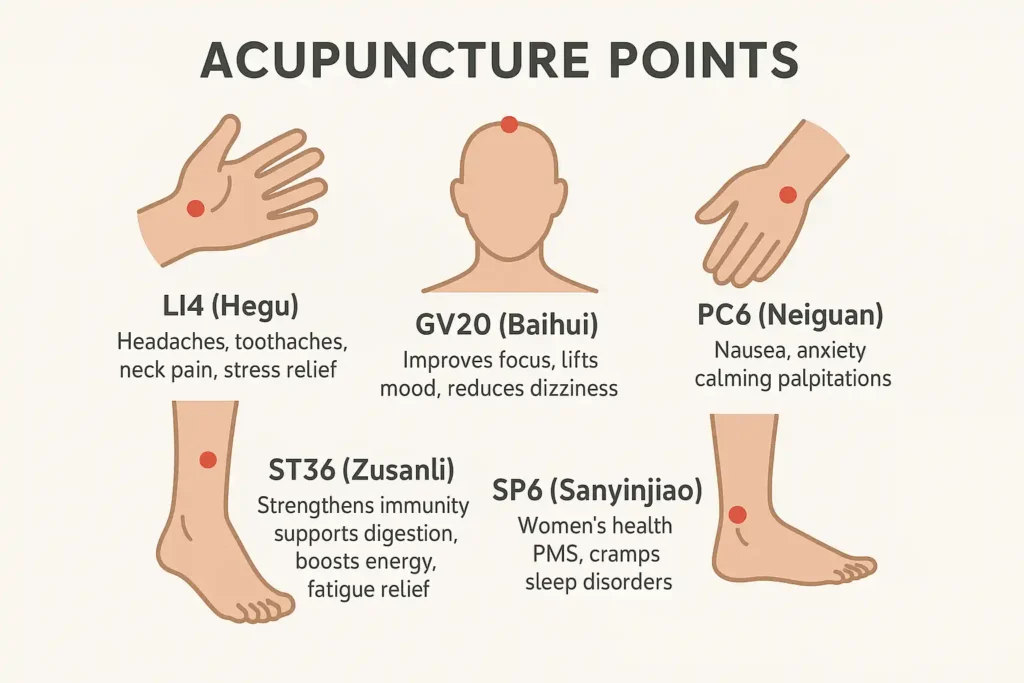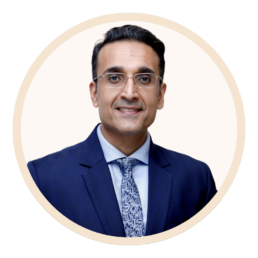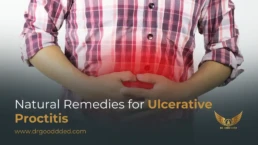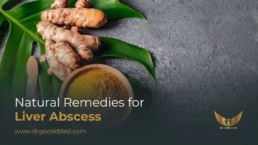Acupressure points have been used for thousands of years to ease pain, improve energy, and bring balance to the body. Today, acupressure massage and acupressure treatment are gaining attention as safe, natural alternatives to medication. Instead of only treating symptoms, they address the body as a whole.
Table of Contents
ToggleThis article explores what acupressure is, how it works, where the main points are located, and the real health problems it can help with. We’ll also discuss precautions and answer common questions people ask before trying pressure point massage.
What Is the Theory Behind Acupressure?
Acupressure points are the foundation of this healing system. According to traditional Chinese medicine, the body is crossed by meridian energy pathways, which carry life force, known as qi. There are twelve main meridians, each linked to organs like the heart, lungs, liver, and stomach.
When qi flows smoothly, you feel well. But if energy slows or gets blocked, problems begin, pain, fatigue, emotional stress, or organ dysfunction. Practitioners believe applying pressure to specific pressure points clears these blockages and restores flow.
Unlike modern medicine, which often looks at isolated organs, acupressure views the body as one web of connections. A symptom in one place may be linked to an imbalance somewhere else.
Example: A patient with frequent migraines may not only be treated at the head. The therapist may focus on points along the liver and stomach meridians, since digestion and liver energy often influence headaches in TCM theory.
This is why acupressure is seen as holistic massage therapy; it balances body, mind, and energy together, rather than chasing individual symptoms.
How Does Acupressure Work?
The benefits of pressure point massage are not just “energy flow.” Modern science has uncovered how the body physically responds:
- Nerve signaling: Pressure activates sensory nerves under the skin. These nerves send messages to the spinal cord and brain. In response, the brain releases endorphins, the body’s natural painkillers.
- Muscle release: Tight spots, often called trigger points, relax under steady pressure. This improves blood flow, oxygen delivery, and removes waste products like lactic acid.
- Circulation boost: Pressure increases microcirculation, which helps repair tissues, reduce swelling, and improve healing.
- Stress control: By calming the nervous system, acupressure lowers cortisol, the main stress hormone, and activates the parasympathetic system, your “rest and digest” mode.
Example: The PC6 point, found three finger-widths down the inner wrist, is famous for nausea control. Clinical studies show cancer patients receiving pressure point stimulation here had less vomiting after chemotherapy compared to those who didn’t.
This explains why acupressure benefits go beyond pain. People report better sleep, improved digestion, calmer moods, and even stronger immune response after regular sessions.
Many people now learn self-acupressure techniques, which are especially valuable. For example, pressing LI4 (between the thumb and index finger) during a tension headache can offer relief without medication.
What Are Common Acupuncture Points?

While there are more than 360 recognized acupressure points, a few are especially useful for everyday health:
- LI4 (Hegu): Between thumb and index finger. Helps headaches, toothaches, neck pain, and reduces stress.
- ST36 (Zusanli): Below the knee. Strengthens immunity, supports digestion, improves energy, and is used in cases of fatigue.
- SP6 (Sanyinjiao): On the inner leg above the ankle. Supports women’s health, helps with PMS, cramps, and sleep disorders.
- PC6 (Neiguan): Inside the wrist. Effective for nausea, anxiety, and calming palpitations.
- GV20 (Baihui): At the crown of the head. Improves focus, lifts mood, and reduces dizziness.
Many practitioners also use reflexology alongside acupressure. Reflexology maps the feet to the body’s organs, pressing the arch of the foot stimulates digestion, while pressing the heel may relieve lower back pain. Combining both methods creates stronger results.
Which Health Problems Benefit From Acupressure?

Acupressure treatment is valued for its wide range of uses, supported by both history and modern studies:
- Chronic pain: Patients with lower back pain or arthritis often find that acupressure reduces stiffness and pain when done regularly.
- Headaches and migraines: LI4 and GV20 are commonly used points. Many migraine patients report fewer attacks after weekly therapy.
- Digestive issues: ST36 and PC6 are used for bloating, constipation, nausea, and loss of appetite.
- Stress and anxiety: A relaxation massage session that includes calming points like SP6 reduces heart rate and lowers anxiety scores.
- Sleep problems: Pressing SP6 and GV20 has been shown to improve sleep time and quality in patients with insomnia.
- Women’s health: From menstrual cramps to hot flashes, specific points regulate hormonal balance and blood circulation.
- Post-surgical recovery: Hospitals now use wrist acupressure bands to control nausea after anesthesia, offering natural pain relief without strong drugs.
Example: A clinical trial in Japan showed cancer patients who practiced daily self-acupressure at LI4 and PC6 had less fatigue and better quality of life compared to those on standard care alone.
This strength lies in mind-body healing. Acupressure doesn’t just silence pain—it restores balance across physical, emotional, and energetic levels.
Are There Any Precautions With Acupressure?
Even though acupressure massage is safe, certain groups need to be careful:
- Pregnant women: Some points may cause contractions.
- Heart patients: Pressure may stress the heart if not done carefully.
- Skin injuries: Avoid pressing near cuts, wounds, or infections.
- Bleeding disorders: Acupressure may worsen bruising in such cases.
Always consult a doctor before using acupressure treatment as a replacement for medical care. Safe practice is important for lasting benefits.
The Bottom Line
Acupressure is a blend of science, tradition, and simple body awareness. By applying pressure to carefully chosen acupressure points, we can improve energy flow, reduce stress, and support healing.
Unlike complex therapies, you don’t always need a specialist. Simple self-acupressure techniques allow you to care for your health at home. Yet, for long-term or serious issues, working with trained therapists ensures better results.
With the rise of drug-free therapies, pressure point massage has become one of the most respected practices in complementary health care.
FAQs
What is acupressure points massage techniques?
It is the practice of pressing or rubbing specific body points to balance energy, reduce pain, improve circulation, and support healing without drugs or needles.
What’s the difference between acupressure and massage?
Massage focuses on muscles and tissues. Acupressure targets specific pressure points linked to energy flow. Both promote relaxation but work differently on the body.
What happens when you massage a pressure point?
It signals nerves, relaxes muscles, boosts blood flow, and releases endorphins. Together, these responses lower pain, reduce stress, and restore balance in the body.
What is acupressure massage therapy?
A therapeutic method using pressure on body points to ease pain, reduce tension, and promote natural pain relief. It supports health and can be done professionally or at home.
What is the 7 pressure point?
It refers to seven key acupressure areas believed to influence energy balance, pain control, and emotional health. Therapists often use them in holistic massage therapy.
Do acupressure points really work?
Yes. Research shows regular acupressure can ease nausea, headaches, and stress. Its effect depends on correct point location, regular practice, and the individual’s health condition.
Which is better, massage or acupuncture?
Massage eases muscle tension. Acupuncture uses needles for deeper energy balance. Acupressure offers needle-free stimulation, making it useful for people seeking a natural, safe therapy.

This article is medically reviewed by Dr. Chandril Chugh, Board-Certified Neurologist, providing expert insights and reliable health information.
Dr. Chandril Chugh is a U.S.-trained neurologist with over a decade of experience. Known for his compassionate care, he specializes in treating neurological conditions such as migraines, epilepsy, and Parkinson’s disease. Dr. Chugh is highly regarded for his patient-centered approach and dedication to providing personalized care.








